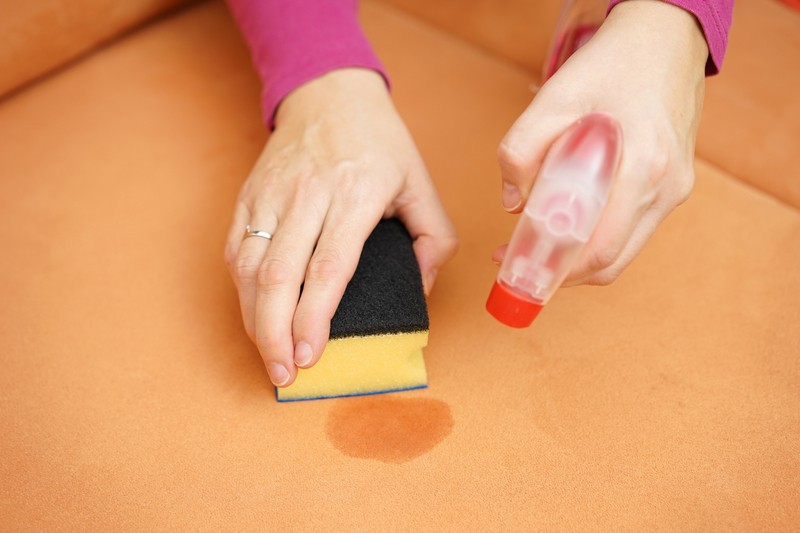Transform Your Space into an Allergen-Reduced Haven
Posted on 11/06/2025
Transform Your Space into an Allergen-Reduced Haven
Are you tired of sneezing, itchy eyes, and constant discomfort in your own home? If dust, pet dander, pollen, or mold are making your life miserable, it's time to take control! Transforming your space into an allergen-reduced haven not only improves your quality of life but also creates a peaceful, healthy, and inviting environment. In this comprehensive guide, you'll learn effective strategies, practical tips, and proven solutions to minimize allergens throughout your home. By implementing these steps, you can breathe easier and truly relax in every corner of your residence.
Understanding Home Allergens: What's Lurking in Your Living Space?
Before diving into solutions, let's understand the most common indoor allergens that can wreak havoc on your health and well-being:
- Dust mites - Microscopic creatures feeding on dead skin, thriving in bedding, upholstery, and carpets.
- Pet dander - Tiny fragments of skin and hair from animals, easily becoming airborne and settling everywhere.
- Pollen - Outdoor allergens that sneak indoors through windows, doors, and on clothes.
- Mold spores - Fungi growing in moist, damp environments like bathrooms, kitchens, or basements.
- Cockroach debris - Droppings and body fragments from invasive pests, especially in urban areas.
Even if you don't visibly see them, these household allergens can trigger asthma, allergies, and other respiratory issues. Let's explore how you can create an allergen-reduced environment right away!

The Allergen-Reduction Roadmap: Strategies for Every Room
A truly allergen-free space might not be possible, but you can dramatically reduce exposure and symptoms. Room by room, here's how:
1. Allergen-Reducing Tips for the Bedroom: Create a Sanctuary of Rest
- Choose Hypoallergenic Bedding:
- Opt for dust mite-proof pillow and mattress encasements; these act as barriers to stop mites from thriving.
- Wash sheets, pillowcases, and blankets in hot water weekly (at least 130?F/54?C) to kill dust mites effectively.
- Select bedding made from natural fibers like cotton or bamboo, which are less likely to trap allergens.
- Minimize Fabrics:
- Replace heavy drapes with easy-to-wash blinds or lightweight curtains.
- Limit throw pillows, stuffed animals, and unnecessary fabric items that attract dust.
- Invest in an Air Purifier:
- Use a HEPA filter air purifier to trap airborne allergens and improve sleep quality.
- Keep windows closed during high pollen seasons, and monitor your local air quality reports.
2. Living Room: Allergen-Reduction Where You Gather
- Flooring Matters:
- Consider replacing carpets with hard flooring (wood, tile, or laminate) as carpets are a haven for dust mites and pet dander.
- Vacuum frequently using a vacuum equipped with a HEPA filter, and mop floors regularly for best results.
- Control Humidity:
- Maintain indoor humidity between 30%-50% to inhibit the growth of mold and dust mites. Use a dehumidifier if necessary.
- Fix any leaks or water stains quickly to prevent mold.
- Declutter:
- Less clutter means fewer surfaces for dust to settle on. Store books, magazines, and knick-knacks in closed cabinets.
3. Kitchen: Tackle Food, Mold, and Pests
- Keep It Dry:
- Wipe up spills immediately, and regularly check under sinks for leaks or damp spots.
- Use an exhaust fan while cooking to reduce moisture buildup and minimize airborne particles.
- Eliminate Food Debris:
- Store food in airtight containers, and dispose of trash daily.
- Clean behind appliances frequently to avoid crumbs that can attract pests.
- Prevent Mold:
- Regularly inspect and clean your refrigerator's drip pan and any other moist areas.
4. Bathroom: Stop Moisture and Mold in Its Tracks
- Ventilate:
- Run a bathroom exhaust fan during and after showers to remove excess humidity.
- Open a window, if possible, to improve air flow.
- Prevent Mold Growth:
- Clean tiles, grout, and shower curtains with a mold-killing cleaner or a simple solution of vinegar and water.
- Replace bath mats and towels frequently, and choose quick-drying fabrics.
5. Pet Areas: Control Dander and Fur
- Regular Grooming:
- Brush pets outdoors to prevent the accumulation of fur and dander inside.
- Bathe your pets as recommended by your veterinarian.
- Limit Pet Access:
- Designate pet-free zones (especially bedrooms) to reduce pet allergen buildup.
- Wash Pet Bedding:
- Clean toys, bedding, and other pet belongings regularly.
6. Entryways: Keep Outdoor Allergens from Invading
- Shoe-Free Policy:
- Encourage family and guests to remove shoes before entering to avoid tracking in pollen, dirt, and more.
- Doormat Defense:
- Place quality doormats both outside and inside each door, and wash them regularly.
- Coat and Bag Storage:
- Designate a closet or storage area for coats and bags to limit allergen spread.
Deep Cleaning: The Backbone of an Allergen-Reduced Home
Routine cleaning is essential to maintain an allergen-minimized environment. Here's how to maximize your efforts:
- Vacuuming: Use vacuum cleaners with true HEPA filters to trap fine particles. Don't just focus on floors – vacuum upholstery, mattresses, and drapes.
- Dusting: Use a damp cloth or microfiber duster that traps particles rather than spreading them.
- Wash Fabrics Frequently: Bedding, towels, curtains, and throw blankets should be washed regularly in hot water.
- Steam Clean Carpets and Upholstery: The heat kills dust mites and helps remove deep-seated dirt.
- Avoid Strong Chemicals: Opt for natural cleaning agents like vinegar, baking soda, or eco-friendly solutions. Fragrances and harsh chemicals can be irritants for sensitive individuals.
- Declutter Spaces: Regularly donate or discard unused items to simplify cleaning and minimize dust-trapping objects.
Air Quality Upgrades: Breathing New Life into Your Haven
The air you breathe at home should be pure and refreshing. To enhance your indoor air quality and transform your space into an allergy-safe oasis, consider:
- HEPA Air Purifiers: These devices capture 99.97% of airborne particles, including dust, pollen, and mold spores.
- HVAC Filters: Replace your HVAC system's filter every 1-3 months with high-efficiency versions designed to trap allergens.
- Regular Ventilation: Open windows when outdoor air quality is good, and use exhaust fans to remove indoor pollutants.
- Houseplants: Certain plants like spider plants, peace lilies, and snake plants can help purify the air. (Note: Some people may be sensitive to mold that can occur in potted soil--ensure proper care and don't overwater.)
- Control Humidity: Use a hygrometer to monitor indoor humidity, and run dehumidifiers as needed to prevent dampness and mold.
Smart Habits for Long-Term Allergen Reduction
Transforming your home into an allergen-minimized zone benefits from consistency. Try to establish these smart habits:
- Designate "Clean Zones": Dedicate certain areas (like the bedroom) as "allergen-free zones."
- Shower Before Bed: Rinse off pollen and outdoor contaminants to prevent transferring them onto bedding.
- Keep Pets Well-Groomed: Regularly bathe and brush pets 'outdoors' if possible.
- Monitor Seasonal Changes: During high pollen times, keep windows closed and use air conditioning with well-maintained filters.
- Avoid Smoking Indoors: Tobacco smoke exacerbates allergies and reduces indoor air quality.
- Track Symptoms: Note when and where symptoms worsen to identify and address trouble spots.
Going the Extra Mile: Professional Solutions for Persistent Allergies
If allergen reduction at home seems overwhelming or your symptoms persist, you might benefit from professional assistance:
- Professional Deep Cleaning: Carpet, upholstery, and air duct cleaning services can remove deeply embedded allergens.
- Allergy Testing: Consulting with an allergist can help pinpoint specific triggers so you can tailor your reduction strategies.
- Mold Inspection and Remediation: Especially in humid climates or if you see recurring mold, professional remediation ensures thorough removal.
- Integrated Pest Management: Reduces risks from cockroach allergens and other pests without relying solely on chemical treatments.
Benefits of an Allergen-Reduced Haven
A home with fewer allergens offers a multitude of benefits:
- Improved Sleep Quality: Fewer nighttime symptoms mean more restful, restorative sleep.
- Less Allergy Medication: Minimized exposure can reduce your dependency on antihistamines or inhalers.
- Enhanced Comfort: A cleaner, fresher environment is inviting for you, your family, and guests.
- Better Long-Term Health: Reduced allergen levels lower risks of asthma attacks and chronic respiratory issues.

Frequently Asked Questions: Allergen-Reduced Spaces
- Q: Is it possible to have a completely allergen-free home?
- A: While total removal is unlikely, you can dramatically reduce allergy triggers with the right measures.
- Q: What's the best investment for reducing indoor allergens?
- A: A high-quality HEPA air purifier and regular cleaning offer significant improvement.
- Q: How often should I wash bedding to reduce dust mites?
- A: Wash all bedding in hot water at least once a week.
- Q: If I have pets, is it possible to minimize dander?
- A: Yes! With strategic grooming, limits on pet access, and frequent cleaning, you can significantly reduce pet allergens.
Conclusion: Breathe Easy in Your Allergen-Reduced Haven
Transforming your home into an allergen-reduced haven is more than just cleaning--it's a holistic lifestyle upgrade. By incorporating the above strategies, establishing healthy habits, and investing in quality air solutions, you're investing in your well-being and peace of mind. Whether allergy season is in full swing or you're simply seeking a healthier lifestyle year-round, there's no better time to create a sanctuary you can truly enjoy. Your journey to an allergen-minimized space starts today—small changes make a big difference. Breathe easier, sleep better, and thrive in your newly refreshed, allergen-reduced home!




